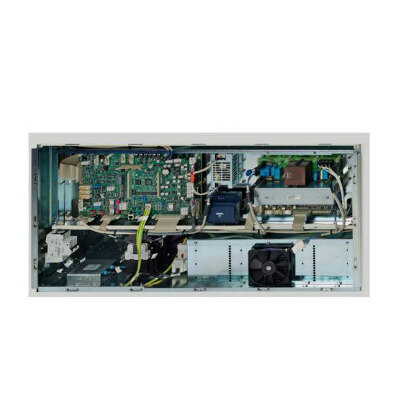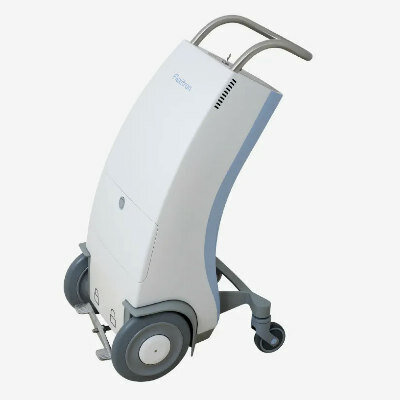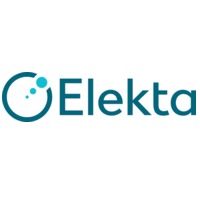More Powerful CT Scans Help Identify Clogged Arteries
By MedImaging International staff writers
Posted on 12 Jan 2009
In a development that researchers reported likely to quash concerns about the value of expensive computed tomography (CT) scans to diagnose coronary artery blockages, an international team of researchers revealed strong evidence that the newer, more powerful 64-CT scans can easily and accurately identify people with major blood vessel disease and is nearly as accurate as invasive coronary angiography.Posted on 12 Jan 2009
Reporting in The New England Journal of Medicine (NEJM) online November 26, 2008, issue, researchers at nine medical centers reported that the faster, 64-CT scans were 93% as precise as invasive, conventional imaging, better known as cardiac catheterization and virtually 100% accurate in detecting individuals with at least one artery dangerously clogged by the buildup of cholesterol and plaque.
Comparison of CT and catheterization results also demonstrated for the first time that they were equally effective in patients with heart attack symptoms, such as chest pain and shortness of breath, for predicting the need for cardiac bypass surgery or angioplasty to restore their blood flow. The CT scans accurately predicted 84% of invasive procedures performed, and catheterization predicted 82%
Senior study investigator and Johns Hopkins University (Baltimore, MD, USA; www.jhu.edu) cardiologist João Lima, M.D., noted that 64-CT scans are not a substitute for catheterization, but the scans, which take between five and 10 seconds to perform, are "an alternative diagnostic tool” physicians can use to "rule in or rule out” coronary blockages when other, more indirect tests for reduced blood flow, such as cardiac stress testing, are unclear or unsafe for a particular patient.
Cardiac catheterization, which also checks the function of heart valves and muscle, takes longer, between 30 minutes and 45 minutes to perform, and requires more than an hour for recovery. Potential complications from the invasive procedure include infection, heart attack, and stroke; however, these events are rare.
Dr. Lima, a professor of medicine and radiology at The Johns Hopkins University School of Medicine and its Heart and Vascular Institute, reported that the 64-CT scans, first introduced to the United States and tested at Hopkins in 2005, could reduce as much as one-fifth of the 1.3 million cardiac catheterizations performed each year nationwide that show no blockages.
CT scans for heart disease, although not yet covered by many private health plans in the United States, could also serve as an alternative to cardiac stress testing, which generally cannot safely be performed on the weak and elderly because the test uses hard exercise to speed up blood flow and measure heart function.
According to Dr. Lima, earlier studies had shown that older, less powerful 16-CT scans were only one-quarter to one-third as precise as the newer tests, "fuelling much heated debate as to whether or not use of the technology could ever be justified. But our latest findings weigh heavily in favor of the more advanced 64-CT scans,” he added, citing additional study results showing that the scans could pinpoint with 91% certainty the precise artery blocked. At four times the strength of the more widely available 16-CT scanner, Dr. Lima stated that the 64-CT scans "provided our first real view of the whole picture of what is going on in the artery, precisely where the blockage is, even if it is only a partially obstructed.”
Lead study investigator and interventional cardiologist Julie Miller, M.D., reported that the advanced scanners are so good that physicians can for the first time measure blockages in blood vessels as small as 1.5 mm in diameter. Older 16-CT scanners, according to Dr. Miller, are best suited for looking inside bigger arteries, those greater in diameter than 2 mm.
Each of the 291 men and women, all over the age of 40, selected to participate in the new study were already scheduled to have cardiac catheterization to check for blocked arteries. Every participant had a 64-CT scan prior to catheterization and was then monitored through regular check-ups, starting in 2005 and set to continue through 2009, to identify who developed or did not develop any heart problems, who required subsequent bypass surgery or angioplasty, and who did not need any procedure.
Researchers found that 90% of the patients without any major blockages were correctly diagnosed with 64-CT scans. The disadvantages of using 64-CT, according to Dr. Miller, are radiation exposure and the rare potential in some people to have an allergic reaction or to develop kidney problems resulting from the contrast dyes injected into the body to enhance the images. "CT technology has come a long way in the last decade,” said Dr. Miller, the leader of angiographic research and an assistant professor at Hopkins. She cited improvements that cut the average amount of radiation exposure and time required for a CT scan to less than 20 millisieverts with 16-CT scanners (which took about 12 seconds to perform), on average, to less than 15 millisieverts with 64-CT devices (at close to 6 seconds), and less than 6 millisieverts with the 320-CT (at less than one second).
Dr. Miller reported that the cost of the newer CT scanning--approximately US$700--compares favorably with that of current nuclear stress testing for reduced blood flow, in which radioactive dyes are used to detect arterial clogs, at nearly $1,000.
In cardiac catheterization, a thin tube is threaded into a blood vessel in the groin area to the heart's arteries, where a dye is released to produce a clear X-ray image of the beating heart and its arterial blood supply. The procedure typically costs in excess of $1,500.
Dr. Miller pointed out that early detection of blockages is critical to preempting a heart attack, allowing time for drug therapy, angioplasty, or heart bypass surgery to be used to keep arteries open. According to Dr. Lima, the investigators next steps are head-to-head comparison studies using either CT or nuclear stress testing, which measures reduced blood flow in areas of the heart to reveal clogging arteries. Included in the next study will be scans performed using an even more advanced scanner, the 320-CT. The latest imaging device was also evaluated at Johns Hopkins in 2006, and it can obtain images in less than a second, with considerable reductions in radiation exposure.
According to researchers, nearly 5,000 64-CT scanners are installed worldwide, but not all of the centers are equipped to perform and read cardiac CT scans. Dr. Miller noted that special training and certification are required by technicians and physicians to accurately perform, read, and interpret the scanned images. The American Heart Association and the American College of Cardiology Foundation in 2005 jointly established training guidelines.
The CT scanner used in the study was an Aquilion 64 multidetector CT scanner, manufactured by Toshiba Medical Systems (Tokyo, Japan).
The study's findings were presented in December 2008 at the annual meeting of the Radiological Society of North America (RSNA), held in Chicago, IL, USA.
Related Links:
Johns Hopkins University














